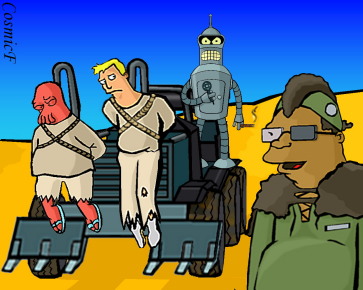Isaac Asimov's "visions" on the possibility of unique robotic identity
THE THREE laws of robotics, embedded in the central computer of the robot coined the positronic brain, are supposedly fool-proof, air-tight restrictions that ensure both the complete obedience of robots and the safety of human beings. Because humans, the maker of robots, thought they could guarantee their own safety by not allowing robots to cause any harm, they expected humanity to live with robots in peace. What they forgot, with the emergence of this new "species," is that humans could still do each other harm. Without keeping this is mind, robots were constructed with the three laws, which simply gave them the obligation to protect humanity and save it from destruction. Conflicts arise when slowly people begin to realize that humans are their own worst enemies.
Robot Visions
Isaac Asimov's Robot Visions had set the groundwork for future robotics, and his three laws have been studied and used ever since. This book is a collection of various "robot visions" that Asimov had, including both short stories and essays. Contradicting the widely-held belief that robots could make our lives more convenient, the stories within Robot Visions present some disturbing thoughts about how robots could "sacrifice" humanity - for the sake of humanity.
The idea that humans are destroying their environment and threatening each other's lives occurs to the intelligent robots. With the duty to stop anything that will harm humans, robots start to eliminate those humans who stage a threat to other humans. This does not necessarily violate the first law, but rather is done in strict obedience to it. Of course, that is not exactly what humans had in mind.

I, Robot
The short stories and articles in Robot Visions, which were later turned into the movie I, Robot, each give a warning about how robots could affect and even alter human lives. There is a "robot Decartes" who seems to possess reason; a future world where the robots, in order to keep humanity under control, have preserved only the very "worthy" citizens; and even a robot "friend" who mesmerizes a little girl, causing her to deny all her other friends and interests. With the appearance of robots that begin to identify themselves as individuals and actually develop their own characters - hence the chilling expression "I, Robot" - the human society has difficulty controlling the mass-produced machines which were originally created to be anything but unique.
* * *
The set of stories and essays by Asimov causes us to ask ourselves: "just exactly how far are modern technology and robotics going to take us?" And also: "are we actually going anywhere with this influx of technological developments and inventions?" Human beings, who have long been known to be rather self-destructive, have now created "helpers" that might also end up "helping" their creators destroy one another. Just as there needs to be a perfect clockmaker to make a perfect clock, there need to be perfect robot-makers in order to create perfect robots. Unfortunately, humans are just not quite perfect enough to create completely submissive machines that will serve us in a way that would not in turn harm our existence.

